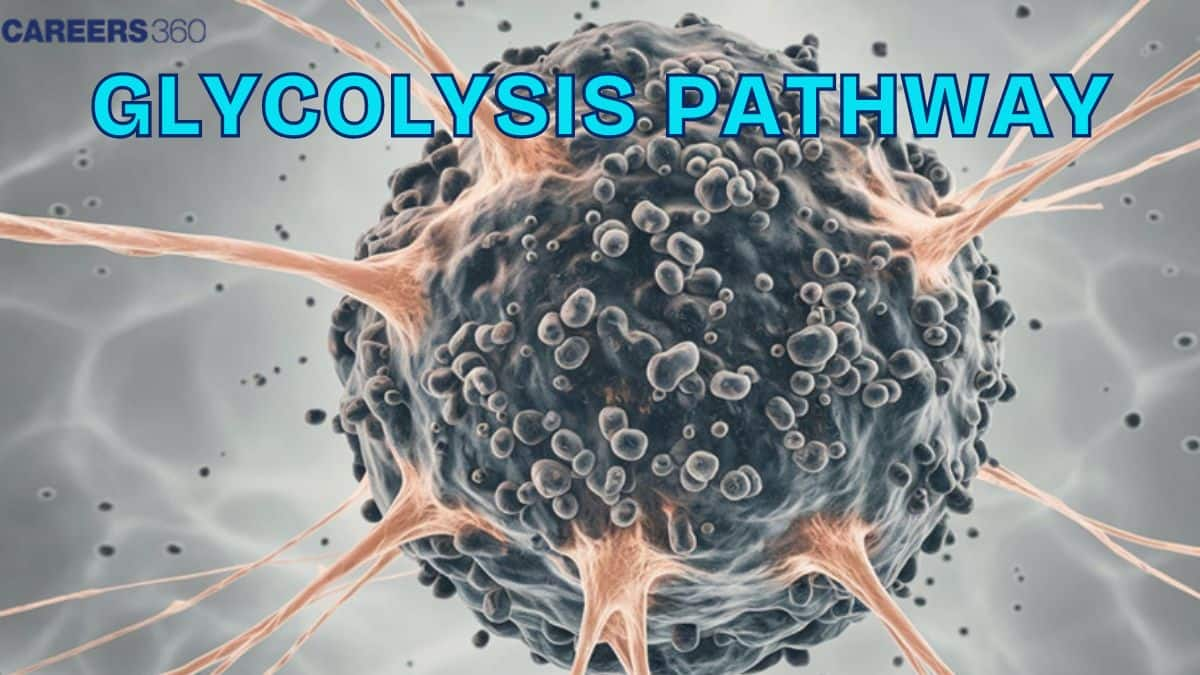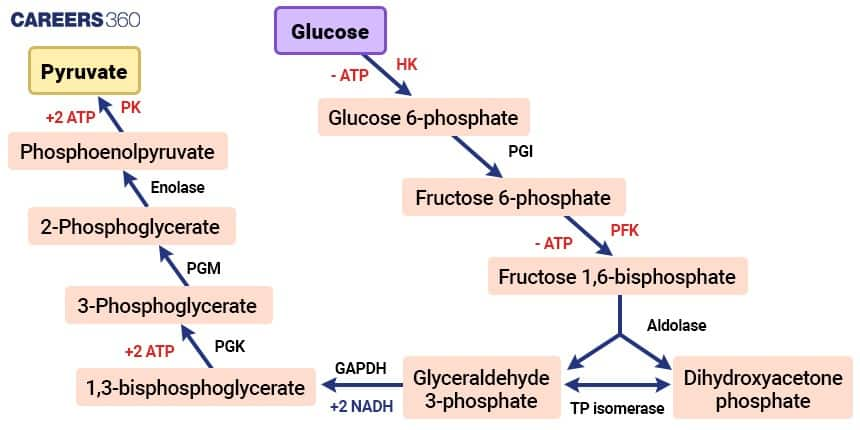Glycolysis Pathway: Pathway, Steps & Products
Glycolysis is the universal, oxygen-independent pathway that converts glucose into two pyruvate molecules, generating ATP and NADH. It occurs in the cytoplasm of all living cells and forms the first step of aerobic and anaerobic respiration. Understanding glycolysis—including its 10 enzyme-driven steps and key regulatory mechanisms—is crucial for NEET and Class 11 Biology.
This Story also Contains
- What Is Glycolysis?
- Where Does Glycolysis Occurs?
- Steps In Glycolysis (10 Steps)
- Outputs Of Glycolysis
- Regulation In Glycolysis
- Glycolysis NEET MCQs (With Answers & Explanations)
- Recommended Video On 'Glycolysis'

What Is Glycolysis?
Glycolysis is a metabolic pathway that converts glucose, a six-carbon sugar molecule, into two molecules of pyruvate, each containing three carbons. The process takes place in the cytoplasm of the cell and leads to the formation of ATP and NADH.
Glycolysis is the first stage in cellular respiration and is very crucial for both aerobic and anaerobic production of energy. It is a rapid means to acquire ATP without entering the oxygen-dependent processes; this feature is especially important for the activity of muscles during high-intensity exercises and in anaerobic organisms.
Where Does Glycolysis Occurs?
The location and role of glycolysis in cellular respiration is discussed below
Cytoplasm
It occurs in the cytosol of prokaryotic cells and the cytoplasm of eukaryotic cells.
Glycolysis is present in almost all the simple types of cells, like bacteria, to the most complex types, like human cells.
Role of Glycolysis In Cellular Respiration
The process of glycolysis initiates the digestion process of the glucose for obtaining energy.
Pyruvate forms feeds into the Krebs cycle as well as the electron transport chain for further energy extraction inside the mitochondria.
Glycolysis also directly yields ATP using substrate-level phosphorylation.
It gives rise to intermediates for other kinds of metabolic pathways and leads to synthesising amino acids and fatty acids as well.
Steps In Glycolysis (10 Steps)
The pathway of glycolysis is further divided into two phases: energy investment phase and energy payoff phase.
Phase 1 — Energy Investment Phase (Steps 1–5)
The first 5 of which constitute the energy investment phase, in which the energy of ATP is invested.
Step 1
Glucose phosphorylation by hexokinase/glucokinase
Glucose is phosphorylated to glucose-6-phosphate with the use of ATP.
Step 2
Isomerisation (Phosphoglucose Isomerase)
Glucose-6-phosphate produced is changed into fructose-6-phosphate.
Step 3
Second phosphorylation (Phosphofructokinase-1)
Fructose-6-phosphate is phosphorylated to fructose-1,6-bisphosphate with the usage of another ATP.
Step 4
Fructose-1,6-bisphosphate Cleavage (Aldolase)
Fructose-1,6-bisphosphate is cleaved into two three-carbon molecules.
Step 5
Isomerisation of DHAP to G3P (Triose Phosphate Isomerase)
DHAP is converted to G3P, resulting in two molecules of G3P.
Phase 2 — Energy Payoff Phase (Steps 6–10)
The energy gain comes in the energy payoff phase of glycolysis, i.e. from step 6 to 10.
Step 6
Oxidation and phosphorylation (Glyceraldehyde-3-Phosphate Dehydrogenase)
G3P is oxidised, producing NADH, and phosphorylated to 1,3-bisphosphoglycerate.
Step 7
ATP generation for the first time (Phosphoglycerate Kinase)
1,3-bisphosphoglycerate does a phosphate add to the ADP to create that ATP, with a by-product of 3-phosphoglycerate.
Step 8
Phosphate is shifted (Phosphoglycerate Mutase)
3-phosphoglycerate is converted to 2-phosphoglycerate.
Step 9
Dehydration (Enolase)
2-phosphoglycerate dehydrated to phosphoenolpyruvate (PEP).
Step 10
Second ATP generation (Pyruvate Kinase)
PEP donates a phosphate group to ADP, to form ATP and pyruvate.

Outputs Of Glycolysis
The products received at the end of Glycolysis:
Products | Description |
Pyruvate | Two molecules of pyruvate per glucose molecule. |
ATP | Net gain of 2 ATP molecules per glucose molecule, this is because whereby 4 is produced, 2 is consumed. |
NADH | Two molecules of NADH per glucose molecule |
Two water molecules per glucose molecule |
Regulation In Glycolysis
The regulation of glycolysis is performed by:
Key Regulatory Enzymes
Hexokinase: The commit regulatory enzyme: inhibited by ATP and citrate; activated by AMP.
Pyruvate Kinase: Catalyses the final step, is inhibited by ATP and alanine, and activated by fructose-1,6-bisphosphate.
Mechanisms
Allosteric Regulation: Enzymes change shape and activity in response to the binding of regulatory molecules
Feedback Inhibition: Inhibition of the end products in early steps to prevent over-accumulation of intermediates and unnecessary use of resources.
Glycolysis NEET MCQs (With Answers & Explanations)
Important topics for NEET are:
Steps in Glycolysis
Regulation of Glycolysis
Practice Questions for NEET
Q1. What is the role of NAD+ in cellular respiration?
It is a nucleotide source for ATP synthesis.
It functions as an electron carrier.
It functions as an enzyme.
It is the final electron acceptor for anaerobic respiration.
Correct answer: 2) It functions as an electron carrier.
Explanation:
At various chemical reactions, the NAD+ picks up an electron from glucose, at which point it becomes NADH. Then NADH, along with another molecule, flavin adenine dinucleotide (FADH2), will ultimately transport the electrons to the mitochondria, where the cell can harvest energy stored in the electrons.
Hence, It functions as an electron carrier.
Hence, the correct answer is Option (2) It functions as an electron carrier.
Q2. In terms of quantity, oxidation of 1 glucose molecule yields
686 Kcal energy
782 Kcal energy
656 Kcal energy
608 Kcal energy
Correct answer: 1) 686 Kcal energy
Explanation:
There is about 686 kcal oxidation for each glucose molecule. Cellular respiration breaks glucose into carbon dioxide and water. The theoretical maximum yield of ATP in this process is about 30 to 38 ATP molecules depending on the efficiency of electron transport and conditions prevailing in the cell. Practical yields are usually much lower because there is a loss of energy in transport and other metabolic processes.
Hence the correct answer is option 1) 686 Kcal energy.
Q3. The number of ‘ends’ in a glycogen molecule would be
Equal to the number of branches plus one
Equal to the number of branch points
One
Two, one on the left side and another on the right side
Correct answer: 4) Two, one on the left side and another on the right side
Explanation:
One should remember that the number of ‘ends’ in a glycogen molecule would be equal to the number of branches plus one. This is because glycogen is a branched polysaccharide, with each branch terminating in a free non-reducing end. The main chain contributes one end, while each additional branch adds another. These ends are crucial for enzymatic action during glycogen synthesis and breakdown. Enzymes like glycogen phosphorylase act on these non-reducing ends to release glucose-1-phosphate during glycogenolysis.
Hence, the correct answer is option 4) Two, one on the left side and another on the right side.
Also Read:
Recommended Video On 'Glycolysis'
Frequently Asked Questions (FAQs)
A few key regulatory enzymes, hexokinase, phosphofructokinase-1 and pyruvate kinase control glycolysis via allosteric interactions, substrate inhibition, and end-product inhibition.
At the end of glycolysis, there will be a net gain of 2 ATP molecules per glucose molecule and an additional 2 NADH.
Glycolysis is a metabolic pathway that breaks down glucose ultimately into pyruvate. This happens in the cytosol of the cells.
There are ten steps in glycolysis, divided into two phases: an energy investment phase and an energy payoff phase.
Glycolysis produces a net amount of ATP and NADH both of which are very important for the energy metabolism of the cell, as well as other metabolic pathways.